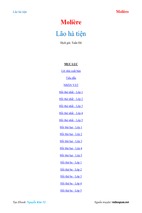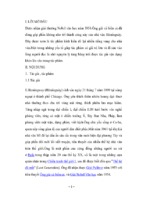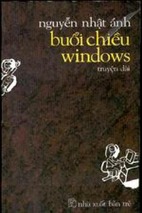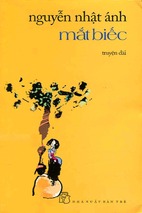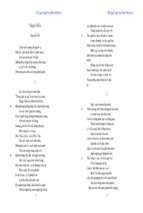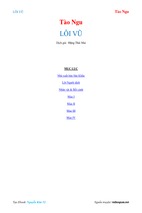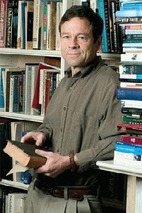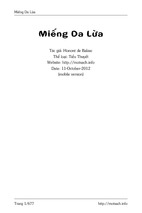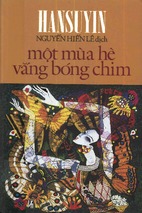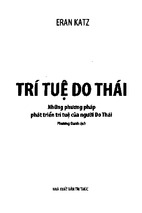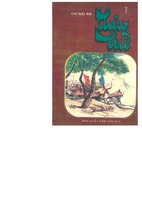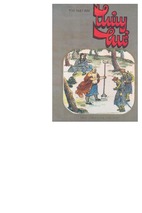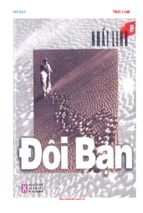JOHN MILTON
PARADISE LOST
Praise for this edition
“Barbara Lewalski is the doyenne of the community of Milton scholars, but she also
remains committed to the enterprise of teaching. In this exemplary edition of
Paradise Lost both qualities are in evidence: the text is scrupulous and the scholarship rigorous, but both the introduction and the notes are accommodated to the needs
of students who will be coming to the poem for the first time. This is an edition
that will please students and professors alike, and its sheer quality is a tribute to Barbara
Lewalski’s passion to provide readers with all the help they need to understand the
greatest of all English poems.”
Gordon Campbell, University of Leicester
“Teachers and scholars will welcome Barbara Lewalski’s Blackwell edition of
Paradise Lost, one not only informed by the erudition of a prominent and highly
respected Miltonist but advantaged by her sound decision to reproduce the original
language, spelling, punctuation, capitalization, and italics of the 1674 text.”
Edward Jones, Editor, Milton Quarterly
“For the student or general reader, looking for an old-spelling edition that is faithful
to the original punctuation, this edition has much to recommend it. Its annotation
is crisp, purposeful and well judged.”
Thomas N. Corns, University of Wales, Bangor
“A superb teaching text. Lewalski’s edition respects Milton’s original poem and
offers supremely clear introductions, bibliography and special material to guide the
student reader and educated lay person alike to new discoveries in a work that, quite
simply, has it all: good, evil, God, Satan, humans, angels, love, despair, war, politics,
sex, duty, and sublime poetry – set in a cosmic landscape that inspires wonder and
seduces new readers in every generation.”
Sharon Achinstein, Oxford University
JOHN MILTON
PARADISE LOST
EDITED BY
BARBARA K. LEWALSKI
Editorial material and organization © 2007 by Blackwell Publishing Ltd
BLACKWELL PUBLISHING
350 Main Street, Malden, MA 02148-5020, USA
9600 Garsington Road, Oxford OX4 2DQ, UK
550 Swanston Street, Carlton, Victoria 3053, Australia
The right of Barbara K. Lewalski to be identified as the Author of the Editorial Material
in this Work has been asserted in accordance with the UK Copyright, Designs, and
Patents Act 1988.
All rights reserved. No part of this publication may be reproduced, stored in a
retrieval system, or transmitted, in any form or by any means, electronic, mechanical,
photocopying, recording or otherwise, except as permitted by the UK Copyright,
Designs, and Patents Act 1988, without the prior permission of the publisher.
First published 2007 by Blackwell Publishing Ltd
1
2007
Library of Congress Cataloging-in-Publication Data
Milton, John, 1608–1674.
Paradise lost / John Milton ; edited by Barbara K. Lewalski.
p. cm.
Text based on the second edition of Paradise lost (1674) in twelve books using
Harvard copy 14486.3 B as copy text.
Includes bibliographical references.
ISBN 978-1-4051-2928-2 (alk. paper) — ISBN 978-1-4051-2929-9 (pbk. : alk. paper)
1. Bible. O.T. Genesis—History of Biblical events—Poetry. 2. Adam (Biblical figure)
—Poetry. 3. Eve (Biblical figure) —Poetry. 4. Fall of man—Poetry. I. Lewalski,
Barbara Kiefer, 1931– II. Title.
PR3560 2007
821′.4—dc22
2006025797
A catalogue record for this title is available from the British Library.
Set in 11/13.5pt Dante
by Graphicraft Limited, Hong Kong
Printed and bound in Singapore
by Markono Print Media Pte Ltd
The publisher’s policy is to use permanent paper from mills that operate a sustainable
forestry policy, and which has been manufactured from pulp processed using acid-free
and elementary chlorine-free practices. Furthermore, the publisher ensures that the text
paper and cover board used have met acceptable environmental accreditation standards.
For further information on
Blackwell Publishing, visit our website:
www.blackwellpublishing.com
Figure 1
Engraved portrait of Milton at age 62 (William Faithorne)
Note on This Edition
This is one of three volumes presenting the complete poetry and major prose of John
Milton in original language and in readily accessible paperbacks. The shorter poems
are edited by Stella Revard; the major prose by David Loewenstein.
Acknowledgments
Librarians at the Houghton Library at Harvard, the Beinecke Library at Yale, the
John Carter Brown Library at Brown, the Henry E. Huntington Library, and the British
Library have graciously made copies of the 1667 and 1674 editions of Paradise Lost
available to me for comparison, and the director of the J. Pierpont Morgan Library
in New York City made available the manuscript of Book 1. I am especially grateful
to the curator of rare books at the Houghton Library for permission to use Harvard
14486.3B (1674) as copy text, and for permission to reproduce William Faithorne’s
engraving of Milton at age 62 (the frontispiece to Milton’s History of Britain, 1670) as
well as the title pages of the 1667 and 1674 editions and the illustrations to Books 2,
5, 8, 9, and 11 from the 1688 Folio edition of Paradise Lost. All the photographs are
courtesy of Houghton Library, Harvard College Library. This project profited
greatly from the wise early guidance of Andrew McNeillie, then literature editor at
Blackwell, the helpful oversight of his successor, Emma Bennett, and the meticulous
care of the copy-editor and project manager, Janet Moth. David Loewenstein and
Stella Revard, editors of the companion volumes to this one, offered useful critiques
and wise counsel; Ken Hiltner served as research assistance during crucial early stages,
and graduate and undergraduate students of Milton over many years have helped
me determine what does and does not need commentary.
Contents
Note on This Edition
Acknowledgments
List of Illustrations
Chronology
Introduction
Textual Introduction
vi
vi
viii
ix
xv
xxx
PARADISE LOST
In Paradisum Amissam Summi Poetæ (S[amuel] B[arrow] M.D.)
On Paradise Lost (A[ndrew] M[arvell])
1
5
8
The Verse
Book 1
Book 2
Book 3
Book 4
Book 5
Book 6
Book 7
Book 8
Book 9
Book 10
Book 11
Book 12
10
11
37
67
91
122
149
175
196
216
251
285
312
Textual Notes
Appendix: Sketches for Dramas on the Fall, from the Trinity Manuscript
Select Bibliography
333
341
344
List of Illustrations
1 Engraved portrait of Milton at age 62 (William Faithorne)
2 First title page to Paradise Lost, 1667
3 Title page to Paradise Lost, 1674
4 Illustration to Book 2, 1688
5 Illustration to Book 5, 1688 ( John Baptista Medina)
6 Illustration to Book 8, 1688 ( John Baptista Medina)
7 Illustration to Book 9, 1688 ( John Baptista Medina)
8 Illustration to Book 11, 1688 ( John Baptista Medina)
v
xxxi
3
36
121
195
215
284
Chronology
Historical and Literary Events
Milton’s Life
Dec. 9, born in Bread Street, Cheapside
London, to John and Sarah Milton.
1608
1611
Educated by private tutors, including
the Presbyterian cleric, Thomas Young.
King James (“Authorized”) Bible.
1614–20
Brother Christopher born.
1615
1616
Portrait at age 10 painted by Cornelius
Janssen.
Begins to attend St. Paul’s School;
friendship with Charles Diodati
begins. (?)
Death of Shakespeare.
Ben Jonson’s Works published.
1618
1620
1621
Donne appointed Dean of St. Paul’s.
1623
Shakespeare’s First Folio published.
First known poems, paraphrases of
Psalms 114 and 136.
1623–4
Admitted to Christ’s College,
Cambridge (Feb. 12).
1625
Death of James I; accession of
Charles I.
Outbreak of plague.
Writes funeral elegies, “In quintum
Novembris,” verse epistles, and
Prolusions in Latin; “On the Death of
a Fair Infant,” “At a Vacation Exercise”
in English.
1626–8
William Laud made Bishop
of London.
x
Chronology
Milton’s Life
Historical and Literary Events
Takes BA degree (March).
Writes “On the Morning of Christ’s
Nativity” (Dec.).
1629
Writes “L’Allegro” and
“Il Penseroso”(?).
1631
“On Shakespeare” published in the
Second Folio of Shakespeare’s plays.
Admitted to MA degree ( July 3).
Writes Arcades, entertainment for the
Countess of Derby(?). Writes sonnet
“How soon hath Time” (Dec.).
Starts to live with his family at
Hammersmith.
1632
Galileo’s Dialogue Concerning the
Two Chief World Systems published
in Italian.
Writes “On Time,” “At a Solemn
Music”(?).
1633
Donne’s Poems and Herbert’s
The Temple published.
Laud made Archbishop of
Canterbury.
A Maske (Comus) performed at
Ludlow with music by Henry Lawes
(Sept. 29).
1634
Carew’s masque, Coelum
Britannicum.
Moves with his family to Horton,
Buckinghamshire. Begins notes on his
reading in Commonplace Book.
1635
Publication of A Maske.
Mother dies (April 3).
Writes “Lycidas.”
1637
“Lycidas” published in collection of
elegies for Edward King.
1638
Begins Continental tour (May 1638);
meets Grotius, Gallileo, Cardinal
Barberini, Manso; visits Academies in
Florence and Rome; visits Vatican
Library; visits Naples, Venice, and
Geneva.
Writes “Mansus,” other Latin poems.
1638–9
Learns of Charles Diodati’s death.
Returns to England ( July).
Takes lodgings in Fleet Street.
Begins teaching nephews Edward and
John Phillips and a few others.
1639
Charles I dissolves Parliament.
Trial and punishment of Puritans
William Prynne, John Bastwick,
and Henry Burton.
Descartes, Discourse on Method.
First Bishops’ War with Scotland.
Chronology
Milton’s Life
xi
Historical and Literary Events
Writes Epitaphium Dæmonis
(epitaph for Charles Diodati).
Begins work on Accidence Commenc’t
Grammar, Art of Logic, Christian
Doctrine(?).
1640
Long Parliament convened
(Nov. 3); impeachment of Laud.
George Thomason, London
bookseller, begins his collection
of tracts and books.
Publishes anti-episcopal tracts: Of
Reformation; Of Prelatical Episcopacy;
Animadversions upon the Remonstrants
Defense.
1641
Impeachment and execution of
Strafford (May)
Root and Branch Bill abolishing
bishops.
Irish rebellion breaks out (Oct.).
Publishes The Reason of Churchgovernment and An Apology [for]
. . . Smectymnuus
Marries Mary Powell (May?), who
returns (Aug.?) to her royalist family
near Oxford.
Writes sonnet, “Captain or Colonel”
when royalist attack on London
expected.
1642
Civil War begins (Aug. 22).
Royalists win Battle of Edgehill.
Closing of theaters.
Publishes Doctrine and Discipline of
Divorce (Aug.).
1643
Westminster Assembly of Divines
to reform Church.
Solemn League and Covenant
subscribed.
Thomas Browne, Religio Medici.
Publishes second edition of Doctrine
and Discipline; Of Education ( June);
The Judgement of Martin Bucer
concerning Divorce (Aug.); Areopagitica
(Nov.).
1644
Royalists defeated at Battle of
Marston Moor ( July 2).
Publishes Tetrachordon and
Colasterion on the divorce
question.
Mary Powell returns. Moves to a large
house in the Barbican.
1645
Execution of Laud.
New Model Army wins decisive
victory at Naseby ( June).
Edmund Waller, Poems.
Poems of Mr. John Milton published
( Jan., dated 1645).
Writes sonnet to Lawes.
Daughter Anne born ( July 29).
1646
First Civil War ends.
Crashaw, Steps to the Temple.
Father dies; moves to High
Holborn.
Begins writing History of Britain(?).
1647
xii
Chronology
Milton’s Life
Historical and Literary Events
Daughter Mary born (Oct. 26).
Writes sonnet to Lord General
Fairfax.
Translates Psalms 80–88.
1648
Second Civil War.
Pride’s Purge (Dec.) expels many
Presbyterians from Parliament,
leaving c.150 members of the House
of Commons (the Rump).
Herrick, Hesperides.
Publishes Tenure of Kings and
Magistrates (Feb.).
Appointed Secretary for Foreign
Tongues to the Council of State
(March 15).
Publishes Observations on Irish
documents; Eikonoklastes (“The Idol
Smasher”) (Oct.).
Given lodgings in Scotland Yard
1649
Trial of Charles I, executed Jan. 30.
Eikon Basilike (“The Royal Image”)
published in many editions.
A republic without King or House
of Lords proclaimed (Feb.).
Salmasius, Defensio Regia.
1650
Marvell, Horatian Ode upon
Cromwell’s Return from Ireland.
Vaughan, Silex Scintillans (Part 1).
Publishes Defensio pro populo Anglicano
in reply to Salmasius
(Feb. 24).
Birth of son, John (March 16).
Moves to Petty France, near
St. James Park.
1651
Hobbes, Leviathan.
Milton totally blind.
Writes sonnet, “When I consider
how my light is spent”(?) and
sonnets to Cromwell and Sir Henry
Vane.
Daughter Deborah born (May 2).
Mary Powell Milton dies (May 5).
Son John dies ( June).
1652
Regii Sanguinis Clamor (“Cry of
the Royal Blood”), answer to
Milton’s Defensio, published.
First Dutch War (to 1654).
Translates Psalms 1–8.
1653
Cromwell dissolves Rump
Parliament (April 20).
“Barebones” Parliament.
Cromwell made Lord Protector
(Dec.), under Constitution,
“Instrument of Government.”
Publishes Defensio Secunda (“A
Second Defense of the English
People”), answer to Regii Sanguinis
(May 30).
1654
Chronology
Milton’s Life
xiii
Historical and Literary Events
Writes sonnet, “Avenge O Lord
thy Slaughter’d Saints.”
Publishes Pro Se Defensio
(“Defense of Himself”) (Aug.).
Works on Christian Doctrine(?).
1655
Massacre of the Protestant Vaudois
on order of the Prince of Savoy
(April).
Marries Katherine Woodcock
(Nov. 12).
1656
James Harrington, Oceana,
published.
Daughter Katherine born (Oct. 10).
Marvell appointed his assistant in
Secretariat for Foreign Languages.
1657
“Humble Petition and Advice,”
constitution establishing more
conservative government.
Katherine Woodcock Milton dies
(Feb. 3).
Daughter Katherine dies (March 17).
New edition of Milton’s Defensio.
1658
Death of Oliver Cromwell (Sept. 3).
Richard Cromwell becomes
Protector.
Publishes A Treatise of Civil Power in
Ecclesiastical Causes (Feb.); The Likeliest
Means to Remove Hirelings out of the
Church (Aug.).
1659
Richard Cromwell deposed by
army; Rump Parliament recalled;
Rump deposed and again restored.
Publishes The Readie and Easie Way to
Establish a Free Commonwealth (Feb.);
2nd edition (April); Brief Notes upon
a Late Sermon (April).
In hiding (May); his books burned
(Aug.); imprisoned (Oct.?); released
(Dec.).
1660
Long Parliament restored; New
Parliament called (April).
Charles II restored, enters London
(May).
Dryden, Astraea Redux.
Bunyan imprisoned (until 1671).
At work on Paradise Lost, Christian
Doctrine.
1661
Regicides imprisoned, ten executed.
Repression of dissenters.
Marries Elizabeth Minshull (Feb.).
Moves to Bunhill Fields.
1663
Butler, Hudibras, Part I.
1664
Butler, Hudibras, Part II;
Molière, Tartuffe.
1665
Bubonic plague kills 70,000 in
London.
Second Dutch War.
1666
Great Fire of London (Sept. 2–6).
Bunyan, Grace Abounding.
1667
Dryden, Annus Mirabilis; Of
Dramatick Poesie.
1668
Dryden made Poet Laureate.
Quaker Thomas Ellwood finds house
for Milton at Chalfont St. Giles to
escape plague.
Paradise Lost published.
xiv
Chronology
Milton’s Life
Historical and Literary Events
Publishes Accidence Commenc’t
Grammar.
1669
Publishes History of Britain, with
William Faithorne’s engraved portrait.
1670
Publishes Paradise Regained and Samson
Agonistes.
1671
Publishes Art of Logic.
1672
Charles II Declaration of
Indulgence.
Marvell, Rehearsal Transprosed.
Third Dutch War.
Publishes Of True Religion, Heresy,
Schism and Toleration; publishes new
edition of Poems (1645).
1673
Test Act passed.
Publishes Familiar Letters and Prolusions.
Publishes 2nd. edition of Paradise Lost.
Death (Nov. 8–10?); burial at St. Giles,
Cripplegate (Nov. 12).
1674
Dryden’s rhymed drama The State of
Innocence, registered (published
1677).
1678
Bunyan, Pilgrim’s Progress.
4th (Folio) edition of Paradise Lost:
illustrations chiefly by Juan Baptista de
Medina, engraved chiefly by Michael
Burghers.
1688
Milton’s Letters of State published, with
Edward Phillips’ Life of Milton and four
sonnets – to Fairfax, Cromwell, Vane,
and Cyriack Skinner (#2) – omitted
from 1673 Poems.
1694
Introduction
In the Proem to Book 9 of Paradise Lost, Milton states that he had thought long and
hard about the right epic subject, “Since first this Subject for Heroic Song / Pleas’d
me long choosing, and beginning late” (9.25–6). As early as 1628, as an undergraduate student at Cambridge, he had declared his desire to write epic and romance in
English, in the vein of Homer and Spenser, about “Kings and Queens and Hero’s old
/ Such as the wise Demodocus once told / In solemn Songs at King Alcinous feast”
(“At a Vacation Exercise,” ll. 47–9). He first supposed he would write an Arthuriad.
In late 1638, while on his European tour, he outlined to Giovanni Battista Manso,
the patron of Tasso, his hope to follow Tasso in writing a national epic, specifying
as subject King Arthur and the Round Table and the early British kings battling the
Saxons (“Mansus,” ll. 78–84). He reiterated that hope a year or so later, in his funeral
elegy for his dear friend Charles Diodati (“Epitaphium Dæmonis,” ll. 162–8). But
by 1642 he had determined that the Arthur stories lacked the basis in history that
he, like Tasso, thought an epic should have, and he now proposed, in the long personal preface to the second book of his antiprelatical treatise, The Reason of Churchgovernment, Urg’d against Prelaty, to find a likely British subject and Christian hero in
some “K[ing] or Knight before the [Norman] conquest.” Alluding to the Horatian
formula widely accepted in the Renaissance, that poetry should teach and delight,
he framed that formula in national terms: to adorn “my native tongue” and to “advance
Gods glory by the honour and instruction of my country.” To achieve that goal,
he considered whether epic or drama might be “more doctrinal and exemplary to
a Nation.”
He had been thinking seriously about drama. Between 1639 and 1641 he listed
(in what is now known as the Trinity Manuscript) nearly one hundred possible
literary projects. That list includes only one epic subject, clearly historical, “founded
somewhere in Alfreds reigne”; the rest are subjects for tragedies drawn from the Bible
and British history, among them four brief sketches for a tragedy on the Fall (see
appendix). The two longer versions call for five acts, the Fall occurring offstage,
xvi
Introduction
a mix of biblical and allegorical characters, and a “mask of all the evills of this life
& world.” Milton’s nephew Edward Phillips, who was also his pupil and sometime
amanuensis, saw several verses for the beginning of such a tragedy, including ten
lines Milton later used in Satan’s speech on Mount Niphates (PL 4.32 – 41). Milton’s
early reflections on the Fall as tragedy may have influenced several very dramatic
scenes in the epic: Satan’s speeches to his followers, the dialogue between God and
the Son in Heaven, the Satan–Abdiel debate, Adam and Eve’s marital dispute, the
temptations, recriminations, and reconciliation of Adam and Eve. But at some point
Milton decided that the Fall and its consequences, “all our woe,” was the great epic
subject for his own times: not the celebratory founding of a great empire or nation
as in the Aeneid, but the tragic loss of an earthly paradise and with it any possibility
of founding an enduring version of the City of God on earth.
He may have begun Paradise Lost a year or two before the restoration of the monarchy in 1660 and continued it in the years immediately following that event. At this
point he could draw upon almost half a century of study, reflection, and experience.
When the English Civil War broke out in 1642 Milton decided to put his large literary projects on hold so as to place his pen in the service of reforming the English
church and state. In a series of treatises written over two decades he addressed
himself to the fundamental reforms he thought would advance the liberties of
Englishmen. Many of those reforms were far more radical than most of his compatriots could accept: removal of bishops from state and church office, church disestablishment, wide religious toleration, separation of church and state, unlicensed
publications and the free circulation of ideas, reformed education along humanist
lines, divorce on grounds of incompatibility, the abolition of monarchy, regicide when
warranted, and republican government. A few weeks after the execution of Charles
I in 1649 Milton was appointed Secretary for Foreign Tongues to the new republic
and held that post under the Protectorate until 1659. His duties involved translating
his government’s formal correspondence with other states, translating in conferences
with foreign diplomats, and writing treatises in English and Latin defending the
regicide and the new English commonwealth. He began these activities with high
hopes that the English people would rally to the “Good Old Cause” of religious and
political liberty, but over time he became increasingly distressed by what he saw as
their “servility” in supporting a national, repressive church and seeking the restoration of the monarchy.
His private life was also replete with challenges, joys, and sorrows: anxiety about
the choice of vocation, the pleasures of friendship, the deep delight of creating splendid poetry, marriage with an incompatible spouse who left him for nearly three years,
the deaths of his dearest friend, two wives, and an infant son and daughter, years of
worry about failing eyesight, total blindness in 1652 with his great poetry yet
unwritten and his public duties still urgent. The personal crises of his marriage to
Mary Powell and his blindness would have profound implications for his great epic,
a poem written by a blind bard in which the tensions of marriage, as well as its
Introduction
xvii
pleasures, are central. Milton poured into his epic all that he had learned and
thought and experienced, about life, love, artistic creativity, religious faith, work,
history, politics, man and woman, God and nature, liberty and tyranny, monarchy
and republicanism, learning and wisdom.
In the Proem to Book 7 Milton refers to the circumstances in which he wrote
much of Paradise Lost: “On evil dayes though fall’n, and evil tongues; / In darkness,
and with dangers compast round” (ll. 26–8). In the Restoration milieu Puritan dissenters were severely repressed, and several of Milton’s regicide friends and associates were executed by the horrific method of hanging, drawing off the blood,
disemboweling, and quartering. Just after Charles II returned in May 1660 Milton
had reason to fear a similar fate for himself: he hid out in a friend’s house for more
than three months and was then arrested and spent some weeks in prison. When
that immediate danger passed he had to come to terms with his profound disappointment over the utter defeat of his political and religious ideals, with his muchreduced financial circumstances, with his daughters’ resentment over their restricted
lives and limited prospects, and with the enormous problem of writing his great poem
as a blind man forced to rely on ad hoc arrangements with students and friends to
take down dictation. In 1665, before the poem was ready for the printer, Milton left
London with his family to escape a particularly lethal visitation of the plague, settling in the country village of Chalfont St. Giles. When he returned the next year,
he experienced the terror of the Great Fire of London which devastated two-thirds
of the City and came within a quarter-mile of his house.
Before publication Paradise Lost had to be licensed in accordance with the Press
Act of 1662. There was brief trouble with the censor, Thomas Tomkyns, who
objected to lines 594–9 of Book 1, with their reference to a solar eclipse portending
“change” that “perplexes Monarchs.” But in the autumn of 1667 the epic was published by Samuel Simmons, one of the few printing houses left standing after the
fire. At the end of April 1667 Milton signed the first recorded formal contract assuring intellectual property rights and payments to an author: five pounds when copy
was delivered, five pounds when 1,300 copies were sold from an edition of 1,500 copies,
then the same sum again upon sale of 1,300 (of 1,500) copies from the second and
from the third editions. These amounts compare with payments to some other early
modern authors; many were paid only with a few copies of their work. In 1674, four
months before Milton’s death, the second edition of Paradise Lost was published, revised
from ten books to twelve.
“Things Unattempted Yet in Prose or Rhime”
Milton’s epic is pre-eminently a poem about knowing and choosing – for the
Miltonic Bard, for his characters, and for the reader. It foregrounds education, a lifelong concern of Milton’s and of special importance to him after the Restoration as
xviii
Introduction
a means to help produce discerning, virtuous, liberty-loving human beings and citizens. Unlike any other literary or theological treatment of the Fall story, almost half
the poem is given over to the formal education of Adam and Eve, by Raphael before
and by Michael after the Fall. God himself takes on the role of educator as he engages
in dialogue with his Son about humankind’s fall and redemption (3.80–265) and with
Adam over his request for a mate (8.357–451). Adam and Eve’s dialogues with
each other involve them in an ongoing process of self-education about themselves
and their world. Milton educates his readers by exercising them in imaginative
apprehension, rigorous judgment, and choice. By setting his poem in relation to other
great epics and works in other genres he involves readers in a critique of the values
associated with those other heroes and genres, as well as with issues of politics
and theology.
Milton’s allusions in the Proems and throughout the poem continually acknowledge structural and verbal debts to the great classical models for epic or epic-like
poems – Homer, Virgil, Hesiod, Ovid, Lucan, Lucretius – and to such moderns as
Ariosto, Tasso, Du Bartas, Camoëns, and Spenser. The reader familiar with these
texts will notice many more such allusions than can be indicated in the annotations
to this edition. Milton incorporates many epic topics and conventions from the Homeric
and Virgilian epic tradition: an epic statement of theme, invocations both to the Muse
Urania and to the great creating Spirit of God, an epic question, a beginning in medias
res, a classical epic hero in Satan, a Homeric catalogue of Satan’s generals, councils
in Hell and in Heaven, epic pageants and games, and supernatural powers – God,
the Son, and good and evil angels. Also, a fierce battle in Heaven pitting loyal angels
against the rebel forces, replete with chariot clashes, taunts and vaunts, hill-hurlings,
and the single combats of heroes; narratives of past actions in Raphael’s accounts of
the War in Heaven and the Creation; and Michael’s prophetic narrative of biblical
history to come.
Yet the Bard claims in the opening Proem that he intends to surpass all those earlier epics, that his “adventrous Song” will soar “Above th’Aonian Mount” (1.13, 15).
He clarifies what this means in the Proem to Book 9, as he takes pride in having
eschewed “Warrs, hitherto the onely Argument / Heroic deem’d” and in having defined
a new heroic standard, “the better fortitude / Of Patience and Heroic Martyrdom”
(9.28–32). He has indeed given over the traditional epic subject, wars and empire,
and the traditional epic hero as the epitome of courage and battle prowess. His
protagonists are a domestic pair, the scene of their action is a pastoral garden, and
their primary challenge is, “under long obedience tried,” to make themselves, their
marital relationship, and their garden – the nucleus of the human world – ever more
perfect. In this they fail, but at length they learn to understand and identify with the
new heroic standard embodied in a series of heroes of faith and especially in the “greater
man,” Christ, who will redeem humankind. For this radically new epic subject, as
the Proems to Books 1, 3, 7, and 9 state, Milton hopes to obtain from the divine
source of both truth and creativity the illumination and collaboration necessary to
Introduction
xix
conceive a subject at once truer and more heroic than any other. He makes bold
claims to originality as an author, but an author who is also a prophetic bard.
In addition to the new epic subject, Milton’s poem holds other surprises for its
readers, then and now. First, and most striking, perhaps, is his splendid Satan, taken
by many critics from the Romantic period to the early decades of the twentieth century as the intended or unintended hero of the poem. Milton presents him, especially
in Books 1 and 2, as a figure of power, awesome size, proud and courageous bearing, regal authority, and, above all, magnificent rhetoric: this is no paltry medieval
devil with grotesque physical features and a tail. He is described in terms of constant allusions to the greatest heroes – Achilles, Odysseus, Aeneas, Prometheus, and
others – in regard to the usual epic traits: physical prowess, battle courage, anger,
fortitude, determination, endurance, leadership, and aristeia or battle glory. Through
that presentation Milton engages readers in a poem-long exploration and redefinition
of heroes and heroism, often by inviting them to discover how Satan in some ways
exemplifies but in essence perverts those classical models. Moreover, Satan’s moving
language of defiance against tyranny and laments for loss are powerfully attractive,
posing readers the difficult challenge of discerning the discrepancies between Satan’s
noble words and his motives and actions. At length Milton invites readers to measure
all other versions of the heroic against the self-sacrificing love of the Son of God, the
moral courage of Abdiel, and the “better fortitude” of several biblical heroes of faith.
Milton’s representations of Hell, Heaven, and Eden also challenge readers’ stereotypes in his own age and ours. All these regions are in process: the physical conditions of the places are fitted to the beings that inhabit them, but the inhabitants interact
with and shape their environments, creating societies in their own image. Hell is
first presented in traditional terms, with the fallen angels chained on a lake of fire.
But unlike Dante’s Inferno, where the damned are confined within distinct circles
to endure an eternally repeated punishment suited to their particular sins, Milton
presents a damned society in the making. His fallen angels rise up and begin to mine
gold and gems, build a government center, Pandæmonium, hold a parliament, send
Satan on a mission of exploration and conquest, investigate their spacious and
varied though sterile landscape, engage in martial games and parades, perform music,
compose epic poems about their own deeds, and argue hard philosophical questions
about fate and free will. Their parliament in Book 2 presents an archetype of
debased and manipulated political assemblies and of characteristic political rhetoric
through the ages. The powerful angelic peers debate issues of war and peace in the
council chamber while the common angels are reduced to pygmy size outside. Moloch,
the quintessential hawk, urges perpetual war at any cost; Belial counsels peace through
ignominious inaction; Mammon would build up a rival empire in Hell founded on
riches and magnificence but, ironically, describes that course of action in the language
of republican virtue, as a choice of “Hard liberty before the easie yoke / Of servile
Pomp” (2.256–7). Then Satan sways the council to his will through the agency of
his chief minister, Beelzebub. The scene closes with Satan accorded divine honors
xx
Introduction
in an exaggerated version of the idolatry Milton had long associated with the Stuart
ideology of divine kingship.
Milton’s Heaven is even more surprising: instead of the expected stasis in perfection, it is also in process, requiring the continued and active choice of good, as Raphael
explains to Adam: “My self and all th’ Angelic Host that stand / In sight of God
enthron’d, our happie state / Hold, as you yours, while our obedience holds”
(5.535–7). As a celestial city that combines courtly magnificence with the pleasures
of nature, it offers an ideal of wholeness through a mix of heroic, georgic, and
pastoral modes. Angelic activities include elegant hymns suited to various occasions,
martial parades, defensive warfare to put down rebellion, pageantry, masque dancing, feasting, political debate, guarding Eden, and, most surprisingly, angelic sex. This
representation of Heaven seems to imply an affirmative answer to Raphael’s suggestive
question, “what if Earth / Be but the shaddow of Heav’n, and things therein / Each
to other like, more then on earth is thought?” (5.574–6).
Underlying this conception is the philosophical monism Milton also set forth in
his Latin theological treatise, De Doctrina Christiana (The Christian Doctrine), a longterm project still under preparation while Milton was composing his epic. Both
treatise and poem repudiate the Neoplatonic dualism common to most seventeenthcentury Christians, and to Milton himself in his early poems, which understands God
and the angels to be pure spirit while humans are a mixture of spirit (the immortal
soul) and gross matter (the body). Challenged, perhaps, by the powerful impact
of Hobbes’ materialism which issued in determinism, and by other speculative
thinkers of the period, Milton developed in treatise and poem a monist ontology
according to which spirit and matter, angels and humans, differ only in degree of
refinement of one corporeal substance emanating from God. Creation is ex Deo (out
of God) rather than ex nihilo (out of nothing) as in most orthodox formulations. Milton’s
theory held that God withdrew from the matter issuing from him so it could become
mutable and subject to the free will of other beings. This concept grounds Milton’s
striking description of Chaos as a region of inchoate matter comprised of constantly
warring elements through which Satan flies with great difficulty and out of which
the Son of God creates the universe. It also underpins Raphael’s discourse to Adam
and Eve (5.469–500), which describes “one first matter” as the substance of all
beings, who can move toward greater (“more spiritous and pure”) refinement or toward
grosser corporeality. Raphael also invokes that principle to explain how he can eat
human food, how humans may expect at length to be transformed “all to spirit” after
long trial of their obedience, and how angels and humans share, proportionally, in
intuitive and discursive reasoning, which differ “but in degree, of kind the same” (5.490).
Milton’s monism results in an unusually fluid conception of hierarchy.
Milton’s portrayal of the Edenic garden and Adam and Eve’s prelapsarian life
also challenges the assumptions of his contemporaries and of most Christian commentators on the Genesis story, as well as many readers’ assumptions about a state
of innocence. Traditionally, Eden was portrayed as a garden replete with all the
- Xem thêm -

